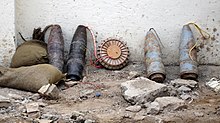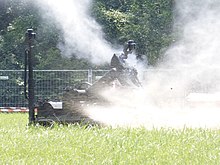Unconventional explosive and incendiary device


An unconventional explosive device or incendiary device ( USBV , also booby trap ) is a non-industrial, often expertly manufactured fire or explosive charge (or fire or booby trap). In English or in NATO troops, one speaks of an IED (English: improvised explosive device ). Sometimes an IED is camouflaged as an object of everyday use at the crime scene, for example in a postal package ( letter or parcel bomb ), a shopping bag, a backpack or a suitcase. A larger USBV can be transported as a car bomb .
composition
IEDs can be chemically produced from freely available resources ( e.g. fertilizers ) . In contrast to industrially manufactured explosives, however , such IEDs usually contain heavier impurities, making the explosives less explosive . Another method is to detonate ammunition - especially artillery shells and bombs - with a small amount of explosives. This variant is mainly used by resistance fighters and partisans in war zones, as the materials are easy to get into possession of, among other things in the form of duds .
USBV are also possible with radioactive, biological or chemical warfare agents, abbreviated USBV-A, USBV-B and USBV-C, the former also called dirty bomb .
Applications

IEDs are used in asymmetric wars by guerrillas or commandos . In the Iraq war or in the period after the war in Afghanistan , suicide bombers use IEDs for attacks or as remote-controlled booby traps. In the Iraq war IEDs are used extensively against soldiers of the coalition forces . By the end of 2007, around 40 percent of all deaths on the part of the coalition were attributed to the use of IEDs. A French study also shows that in Iraq from March 2003 to November 2006 of 3,070 soldiers of the US-led coalition killed, 41 percent (1257) were killed by IEDs and 33 percent (1027) by armed forces. The number of fatalities was increased in particular through the formation of IEDs as projectile- forming charges . The Tamil Tigers also frequently use IED against military and civilian targets.
IEDs are also often used for politically motivated crimes and terrorist attacks . In Germany, for example, this applies to left-wing terrorist groups such as the Revolutionary Cells , the Rote Zora , the Militant Group or the June 2nd Movement , but also the right-wing extremist organization German Action Groups .
Countermeasures
In Germany, police officers are deployed in most federal states to eliminate a potential danger posed by an IED; in Schleswig-Holstein and Mecklenburg-Western Pomerania, for reasons of efficiency and administrative economy , members of the ordnance disposal service or the ammunition recovery service are deployed. You have completed special courses at the Federal Criminal Police Office (BKA) and are known as defusers . The Federal Criminal Police Office also has such specialists. In Lower Saxony, it is employees of the Lower Saxony State Criminal Police Office who have been trained in handling explosives by the German Armed Forces and the British Army on the Rhine, which was formerly stationed here .
In April 2010 the German Armed Forces put the Center Counter-IED , a research institute for the development of countermeasures against unconventional explosive devices, into service at the Grafschaft site .
Since many IEDs in Afghanistan and Iraq were triggered with the help of signals from cell phones , powerful jammers (so-called IED jammers ) were developed that can be used from a vehicle to block such trigger commands for remote-controlled detonators in the vicinity.
See also
- Ordnance disposal
- Pipe bomb
- Suicide bomber , backpack bomber
- Dismantling
- List of explosive attacks
- Combat Defense Training Base (Bundeswehr)
literature
- Frank D. Stolt: Bomb threat / bomb warning. Grimm-Verlag, Berlin 2009, ISBN 978-3-940286-00-0
- Thomas Preuss: Explosives and explosives attacks. Richard Boorberg Verlag, Stuttgart 2012, ISBN 978-3-415-04709-9
Web links
- Christian Dewitz: With high-tech against insidiousness , Bundeswehr-Journal from March 18, 2013
Individual evidence
- ^ Iraq Coalition Casualty Count. Archived from the original on September 28, 2005 ; accessed on February 16, 2014 (English).
- ^ Jean-Pierre Steinhofer: Iraq: les pertes de la Coalition par EEI. In: le Casoar. January 2007.
- ^ Rohan Gunaratna: Suicide Terrorism: A Global Threat Frontline World, pbs.org, October 2000.
- ↑ Central information about booby traps. In: Rhein-Zeitung online. April 28, 2010.
- ↑ Uwe Hessler: German army opens IED research center for soldiers. In: Deutsche Welle online . April 30, 2010. Accessed May 2, 2010. (English, translated by Rob Turner)

